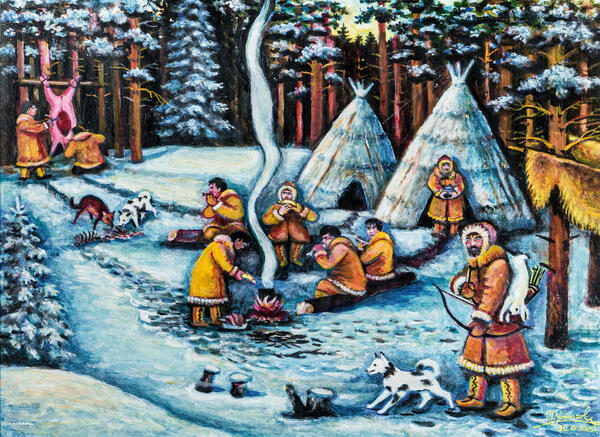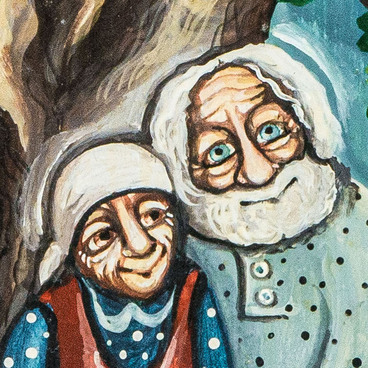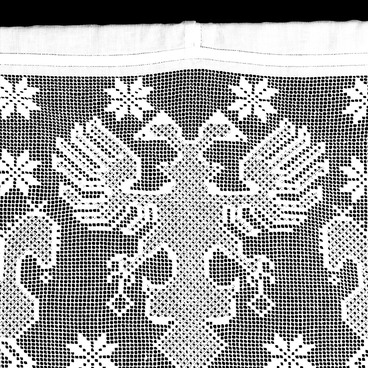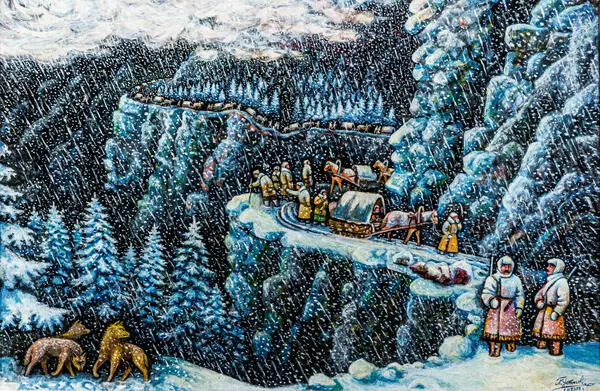Pavel Ustyugov, an artist from Alapaevsk, was born in the village of Verkhnyaya Sinyachikha, Sverdlovsk region in 1922. He fought in the Great Patriotic War from the beginning to the end: until 1942, in an aerosled battalion near Petrozavodsk, and then he studied at a tank crew’s school and went as far as Hungary. Ustyugov was awarded the Order of the Patriotic War of the 2nd degree.
In his later life, Pavel Ustyugov devoted all his free time to painting, creating pictures in the historical genre. The artist, whose ancestors came to the Urals from Veliky Ustyug in the 17th century, strove to preserve the memory of his family and the history of the development of the Urals. In one of the paintings dedicated to the construction of the Irbit road, he depicted a collision of the Voguls — the local indigenous population — with the builders of the road connecting Irbit with Verkhoturye. It was this path that was paved by one of the ancestors of Ustyugov.
The painting ‘Camping of Yasak Voguls on the Sinyachikha River’ is dedicated directly to the life of the Voguls — this is how Russian settlers used to call the Mansi people, one of the indigenous peoples of the Urals. They were called ‘yasak’ because they paid the state tax — ‘yasak’. The tribute was payable in sables, foxes, martens and other game animals.
The main occupations of the Voguls, as well as the source of their food and income, were hunting, fishing, picking berries and mushrooms, and reindeer herding. In addition to deer, the Mansi bred horses and poultry. In the 18th–19th centuries, the Voguls often came to the Irbit fair, where they exchanged the furs, fish and nuts for Russian fabrics, flour, and groats.
In the background of the painting, Ustyugov depicted two chums (tents). This traditional Mansi conical dwelling was made of sturdy poles and covered with bark or skins depending on the season.
The artist used a contrasting color palette with yellow-red and deep blue tones. They enhance the sense of energy in the picture. The characters look directly at the viewer and this adds a sense that what is happening is real: the painting looks like a random real-life picture taken.
Ustyugov emphasizes this resemblance to the photograph by the cropped composition, which does not include the tops of the pines, the hanging hides, and the smoke rising up from the fire.
In his later life, Pavel Ustyugov devoted all his free time to painting, creating pictures in the historical genre. The artist, whose ancestors came to the Urals from Veliky Ustyug in the 17th century, strove to preserve the memory of his family and the history of the development of the Urals. In one of the paintings dedicated to the construction of the Irbit road, he depicted a collision of the Voguls — the local indigenous population — with the builders of the road connecting Irbit with Verkhoturye. It was this path that was paved by one of the ancestors of Ustyugov.
The painting ‘Camping of Yasak Voguls on the Sinyachikha River’ is dedicated directly to the life of the Voguls — this is how Russian settlers used to call the Mansi people, one of the indigenous peoples of the Urals. They were called ‘yasak’ because they paid the state tax — ‘yasak’. The tribute was payable in sables, foxes, martens and other game animals.
The main occupations of the Voguls, as well as the source of their food and income, were hunting, fishing, picking berries and mushrooms, and reindeer herding. In addition to deer, the Mansi bred horses and poultry. In the 18th–19th centuries, the Voguls often came to the Irbit fair, where they exchanged the furs, fish and nuts for Russian fabrics, flour, and groats.
In the background of the painting, Ustyugov depicted two chums (tents). This traditional Mansi conical dwelling was made of sturdy poles and covered with bark or skins depending on the season.
The artist used a contrasting color palette with yellow-red and deep blue tones. They enhance the sense of energy in the picture. The characters look directly at the viewer and this adds a sense that what is happening is real: the painting looks like a random real-life picture taken.
Ustyugov emphasizes this resemblance to the photograph by the cropped composition, which does not include the tops of the pines, the hanging hides, and the smoke rising up from the fire.




